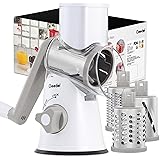Massive Beads Black Tourmaline - Super Protection - Handmade Yoga Stretch Elastic Bracelet Natural Stone Crystal Healing Power Energy Gifts for Unisex Adult 8mm
$9.99 (as of November 24, 2024 21:35 GMT +00:00 - More infoProduct prices and availability are accurate as of the date/time indicated and are subject to change. Any price and availability information displayed on [relevant Amazon Site(s), as applicable] at the time of purchase will apply to the purchase of this product.)Bones Coffee Company S'morey Time Ground Coffee Beans, S'mores and Graham Crackers Flavor, Low Acid Flavored Coffee, Made with Arabica Coffee Beans, Medium Roast Gourmet Coffee (12 oz)
$17.99 (as of November 25, 2024 21:35 GMT +00:00 - More infoProduct prices and availability are accurate as of the date/time indicated and are subject to change. Any price and availability information displayed on [relevant Amazon Site(s), as applicable] at the time of purchase will apply to the purchase of this product.)Super Mario Party Jamboree
$59.99 (as of November 25, 2024 21:35 GMT +00:00 - More infoProduct prices and availability are accurate as of the date/time indicated and are subject to change. Any price and availability information displayed on [relevant Amazon Site(s), as applicable] at the time of purchase will apply to the purchase of this product.)Geedel Rotary Cheese Grater, Kitchen Mandoline Vegetable Slicer with 3 Interchangeable Blades, Easy to Clean Rotary Grater Slicer for Fruit, Vegetables, Nuts
$25.97 (as of November 24, 2024 21:35 GMT +00:00 - More infoProduct prices and availability are accurate as of the date/time indicated and are subject to change. Any price and availability information displayed on [relevant Amazon Site(s), as applicable] at the time of purchase will apply to the purchase of this product.)Hearth and Homestead: Handmade Whipped Tallow Balm (Unscented/Herb-Infused) - Organic Body Butter with Infused Olive Oil, for Eczema, Rosacea, Baby - 1.3 oz
$23.99 (as of November 24, 2024 21:35 GMT +00:00 - More infoProduct prices and availability are accurate as of the date/time indicated and are subject to change. Any price and availability information displayed on [relevant Amazon Site(s), as applicable] at the time of purchase will apply to the purchase of this product.)When it comes to battery chargers, there are numerous options available in the market, each with its unique features and capabilities. With so many choices, selecting the right charger can be a daunting task, especially if you’re not familiar with the technical specifications.
In this article, we’ll delve into the world of battery chargers, exploring their types, features, and benefits. We’ll also provide you with a comprehensive guide to help you choose the perfect charger for your needs.
Types of Battery Chargers
Battery chargers come in various forms, each designed for specific applications:
- Wall Adapters: These are compact chargers that plug directly into a wall outlet, providing a convenient and easy-to-use charging solution.
- Portable Chargers: Also known as power banks or battery packs, these chargers are designed to be carried around and provide an emergency backup power source for devices on the go.
- USB Charging Stations: These chargers feature multiple USB ports, allowing you to charge multiple devices simultaneously from a single outlet.
- Car Chargers: Designed specifically for vehicles, car chargers provide a convenient way to keep your devices charged while driving.
Key Features to Consider
When selecting a battery charger, consider the following essential features:
- Power Output: Measured in watts (W), power output determines how quickly a device can be charged. Look for chargers with high power outputs for faster charging.
- Voltage and Current Ratings: Ensure that the charger matches your device’s voltage and current requirements to avoid damage or overheating.
- Safety Features: Opt for chargers with built-in safety features, such as overcharge protection, short-circuit prevention, and thermal management, to safeguard your devices.
- Certifications: Look for chargers certified by reputable organizations like UL (Underwriters Laboratories), ETL (Intertek), or FCC (Federal Communications Commission) to ensure compliance with industry standards.
Technical Specifications
When evaluating battery chargers, pay attention to the following technical specifications:
- Input Voltage and Current: The charger’s input voltage and current ratings determine how it can be connected to a power source.
- Output Voltage and Current: These specifications indicate what devices the charger is designed to charge and at what rate.
- Efficiency Rating: Measured in percentage, efficiency rating affects how much power is actually delivered to your device, rather than being wasted as heat.
Comparison of Popular Battery Chargers
Let’s compare some popular battery chargers on the market:
- Anker PowerPort USB Charger (12W):
- Input: 100-240V AC
- Output: 5V/2A per port
- Efficiency Rating: 85%
- Aukey Portable Charger (20,000mAh):
- Input: DC 19V/1.75A
- Output: 5V/3A per port
- Efficiency Rating: 90%
- Mophie Powerstation (12,000mAh):
- Input: USB-C PD (PD 2.0), 18W
- Output: 5V/3A per port
- Efficiency Rating: 92%
Conclusion
Selecting the right battery charger for your needs requires careful consideration of various factors, including power output, voltage and current ratings, safety features, certifications, input voltage and current, output voltage and current, and efficiency rating.
By understanding these essential specifications and comparing popular chargers on the market, you can make an informed decision and choose a reliable and efficient battery charger that meets your requirements.









